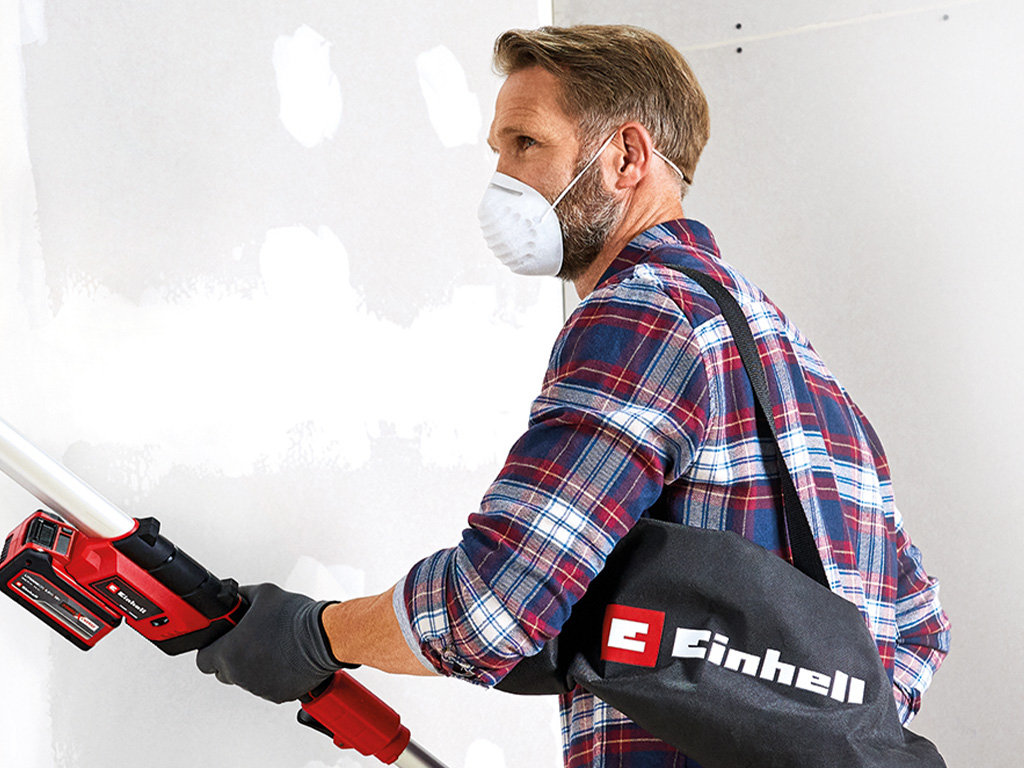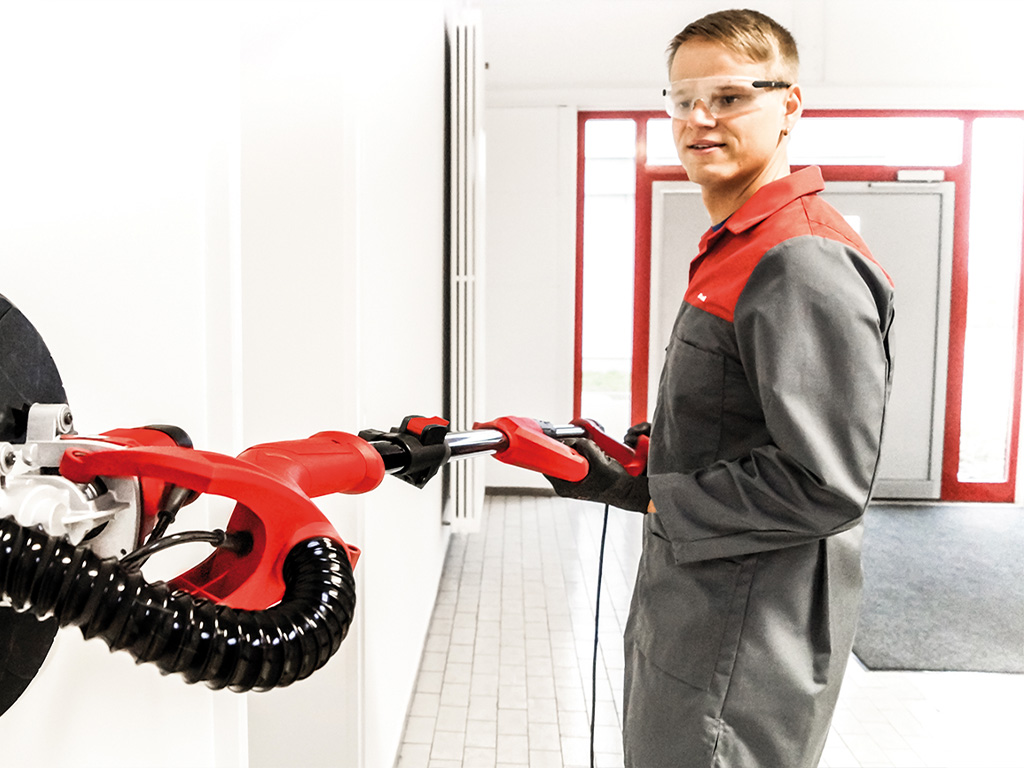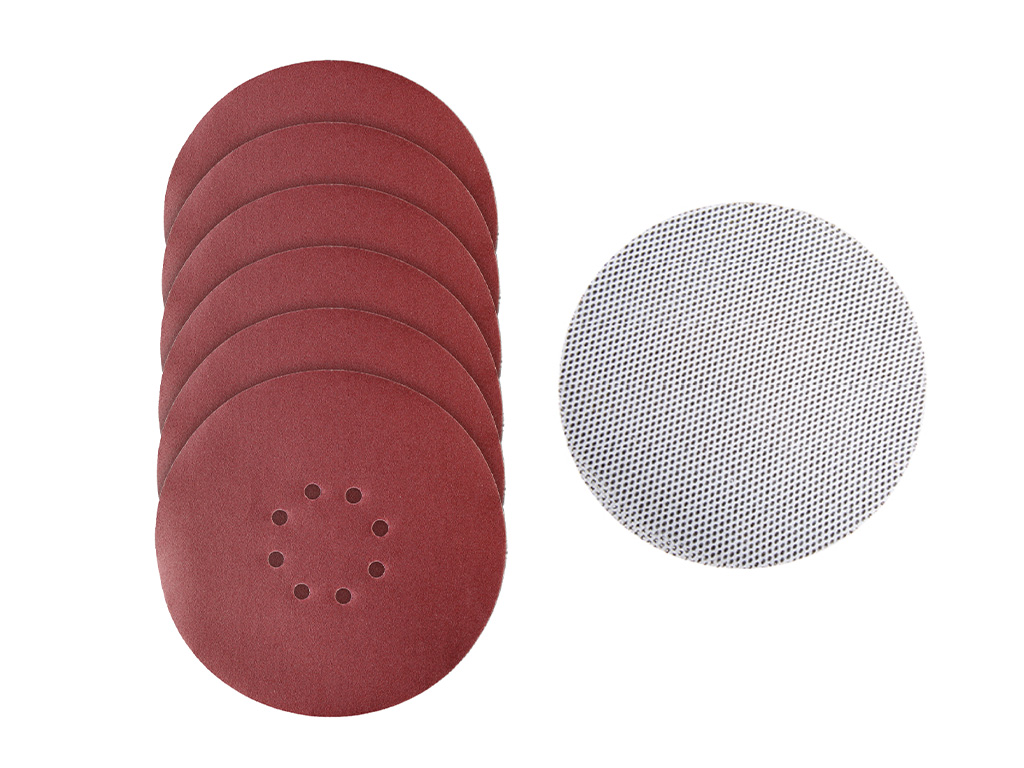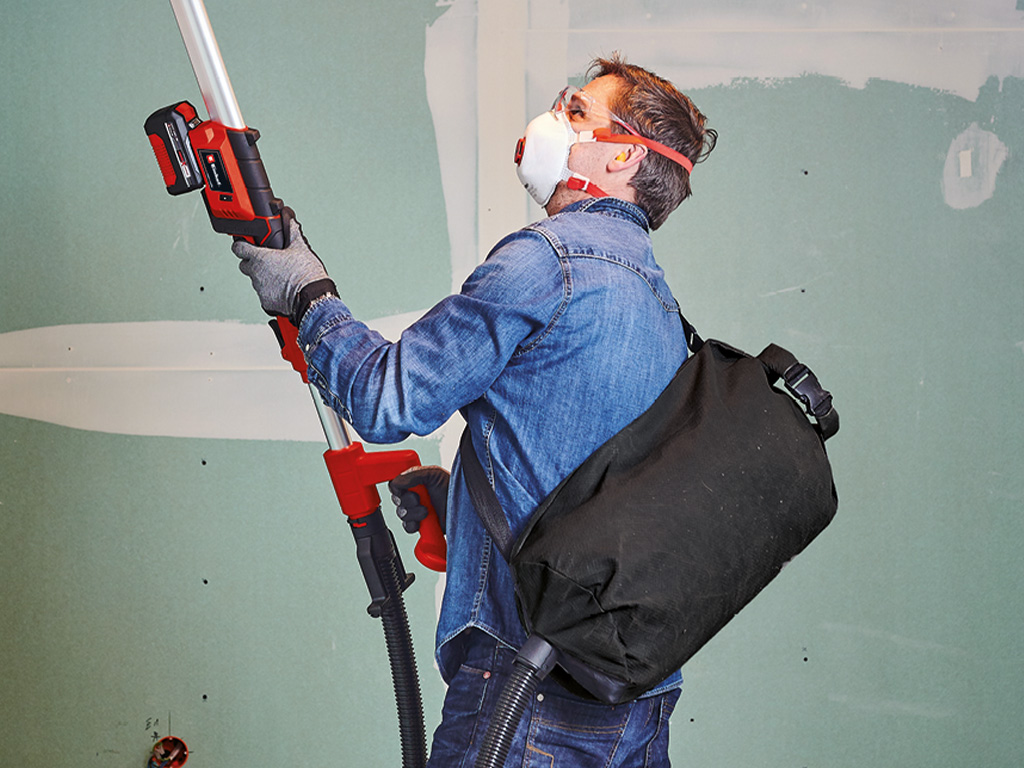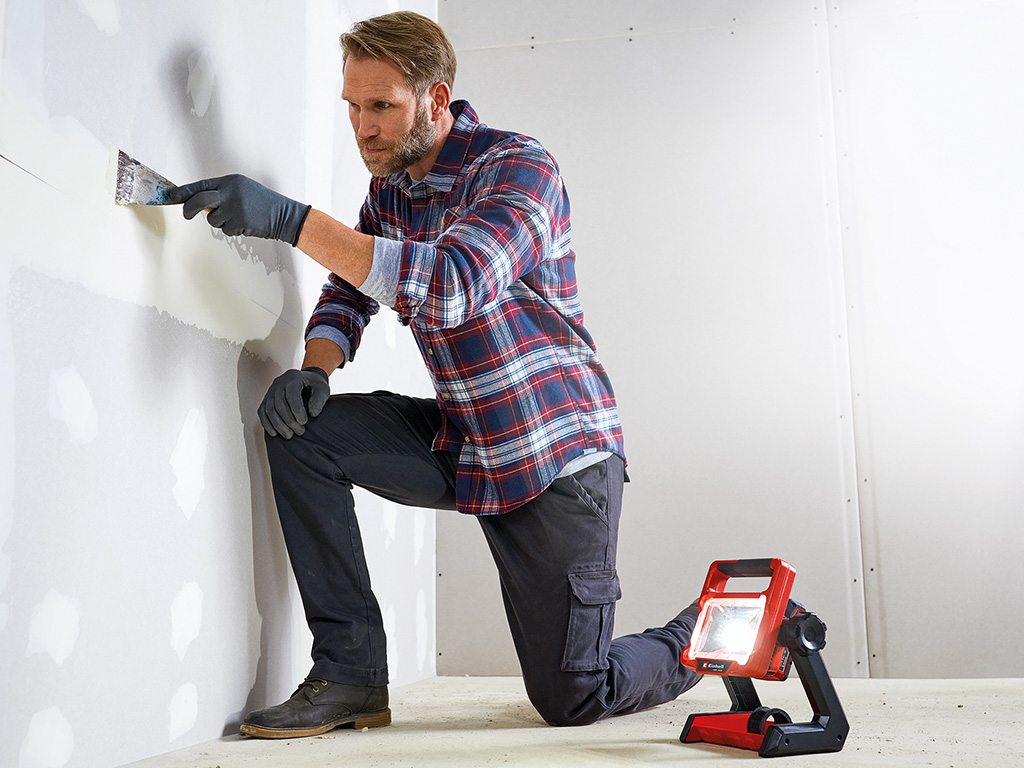The drywall sander in use – tips and info for ambitious DIY enthusiasts
As a DIY pro, this will certainly be familiar to you: When renovating or refurbishing your home, you want to partition off rooms, straighten walls or cover up unsightly brickwork. To do this you'll need to install drywall or plaster walls. Once you have completed the tougher work, such as the construction of the column walls and the installation of the drywall, it's time for the finishing touches and smoothing over any rough edges and excess filler.
And that's not the only place the Einhell drywall sander and polisher comes in handy. It also removes wallpaper residues, adhesive residues, paints, varnishes and loose plaster to prepare surfaces for the next steps, such as painting or wallpapering.
We'll show you exactly what a drywall sander is and how it works, how to properly prepare for work and what you should pay attention to so that you can make sure your wall is ready to work on.
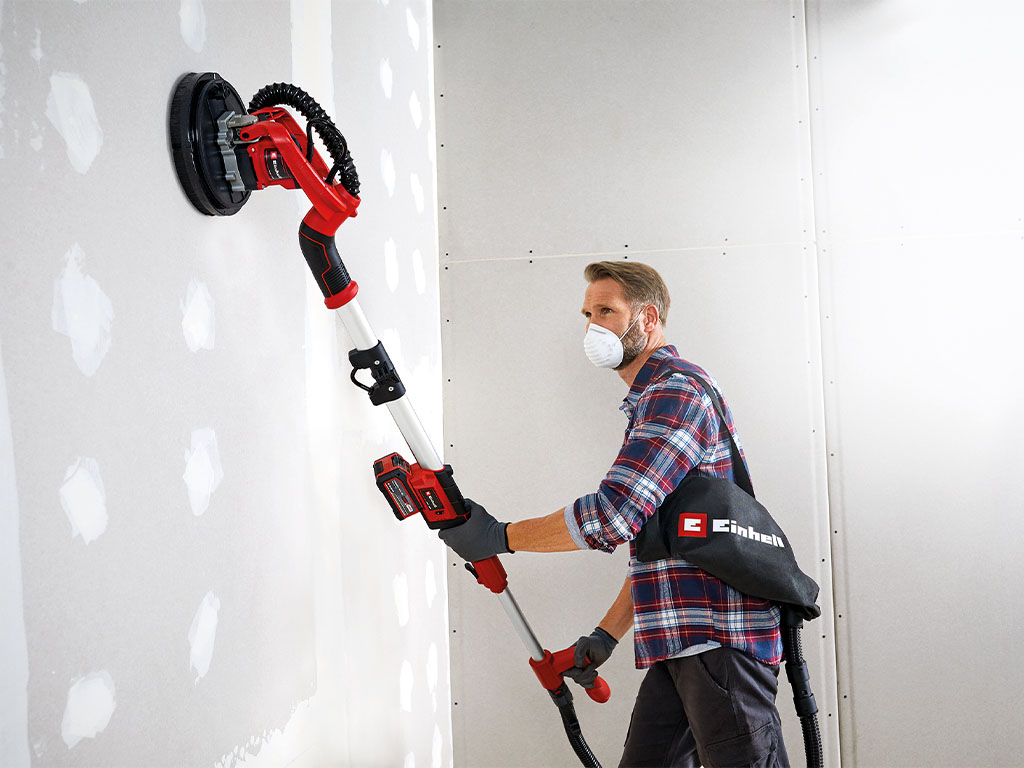
What can a drywall sander do?
To help you work with your drywall after construction, i.e. no unsightly stains arise during painting or wallpapering, the wall needs be sanded down first. It is much easier to work on a flat work surface, e.g. when painting walls.
When working with the plasterboard walls, the plasterboard is screwed to a stand system with the aid of a drywall screwdriver. The resulting screw holes in in the wall, and the screw head that terminates flush with the wall, can be covered over again using filler. The joints between two drywall panels are also smoothed over in this way. The dried, excess filler can be sanded with a drywall sander so that no residue can be seen and an even surface is created.
The Einhell drywall sander models are attached to a 165 cm telescopic handle, which allows you to adjust the sander to all common ceiling heights. You can even comfortably work on high ceilings and smaller staircases. You will also be supported by several freely adjustable joints, which makes it even easier to reach hard-to-reach places with the Einhell drywall sander. You can even turn your sander into a ceiling sander. The Einhell TE-DW 225 X drywall grinder also comes with a triangular sanding wheel that allows you to sand all corners with ease. Thanks to the hook and loop system on the back of the 255 mm sanding wheel, you can easily change the sandpaper and adjust the sanding thickness to the surface thanks to the different grain sizes. Now that you've sanded down your wall, you can continue working on it: plastering, painting, wallpapering or tiling.
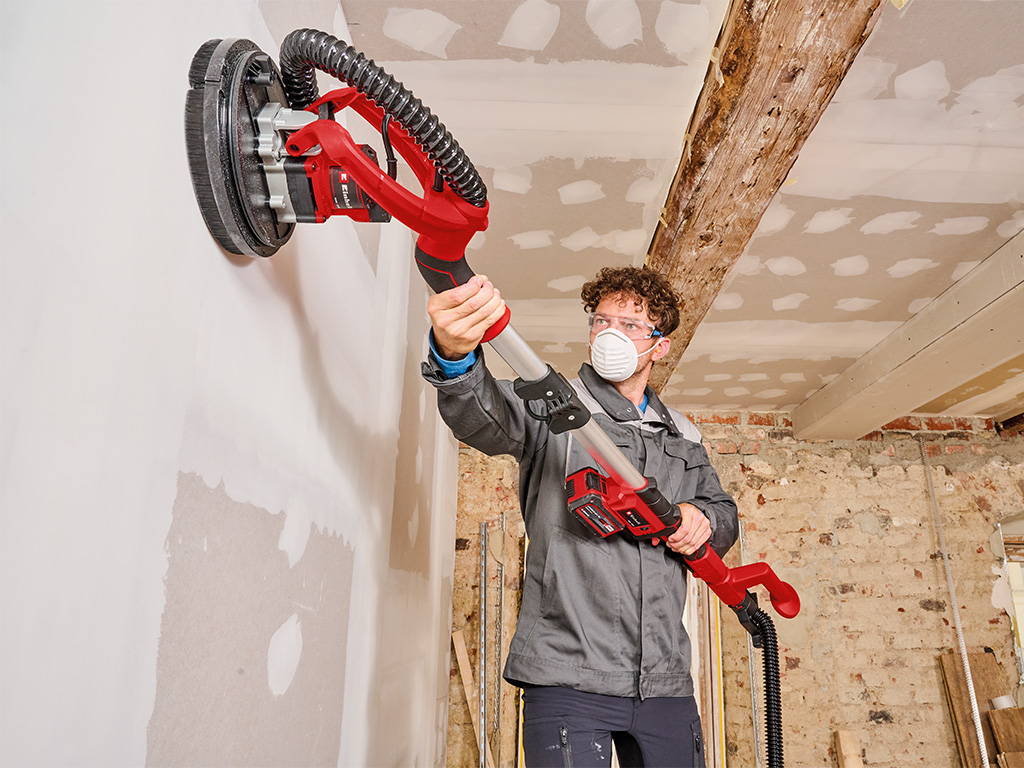
Cordless vs. cabled devices
Our range of Einhell products offers you a whole host of possibilities to find the perfect device for you and your project:
- Einhell drywall sander and polisher TE-DW 225 X
- Einhell drywall sander and polisher TC-DW 225
- Einhell cordless drywall sander and polisher TP-DE 18/225 Li
We have put three devices to the test and compiled the results as a comparison for you. The main difference between the three devices is the power supply: The two cabled devices (TE-DW 225 X and TC-DW 225) are especially recommended for larger projects and for large areas. They impress with a powerful 600 to 750 watt motor. They are also steplessly telescopic and have an articulated bearing on the sanding head, so you can move without restriction and even overhead sanding is no problem, as Einhell drywall sanders can be easily converted into ceiling sanders.
Part of our ever-expanding Power X-Change family, the battery pack works with a 6.0 Ah 18V battery for up to 78 minutes. Its speed electronics ensure material- and application-appropriate work. The automatic dust collection system allows you to sand cleanly and on the move, sending the dirt directly into the dust collection sack.
Generally, it's a good idea to think about which device is best for you before starting your renovation or refurbishment work. If you're working with a large area, we recommend our cable-powered machines. But if you need a flexible and mobile tool that allows you to sand anywhere thanks to cordless battery power, a member of the Power X-Change family is the right device for you.
Same-same but different: The concrete grinder
With its rotating disc, the concrete grinder can machine large wall surfaces, ceilings and floors made of concrete. It grinds and smooths uneven areas such as paint layers, tile adhesives or carpet adhesives. Compared to the drywall sander, the concrete grinder can also be used for grinding and cleaning hard materials such as screed, concrete and granite thanks to its higher performance and attachments such as diamond grinding discs or steel brushes. The drywall sander and polisher, on the other hand, is used for grinding softer materials such as plaster and filler. The concrete grinder, also known as a renovation milling machine, is similar in construction to the drywall sander, but does not have a telescopic handle. This makes the concrete grinder less suitable for work on high walls or ceilings.
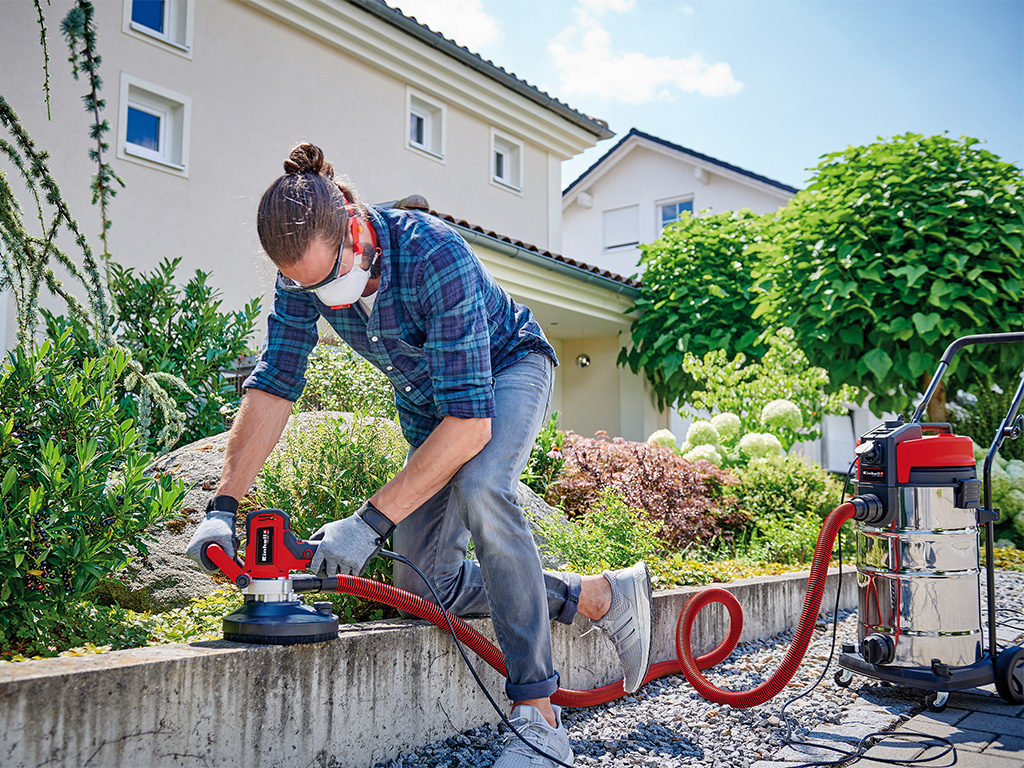
Here are the main advantages of drywall sanders
- Power: Thanks to speed regulation, the performance of the sanders can be optimally adjusted. The continuous running supports time-consuming work.
- Space-saving storage: With the help of the foldable telescopic handle, the telescopic sander can be stored in a space-saving manner. Comes in a practical case.
- Flexible use: Thanks to the telescopic handle or, depending on the model, the removable brush rim edge for working close to the edge or the exchangeable sanding pad, the drywall sanders are flexible in use.
- Clean work: The fine dust generated during sanding is collected with integrated dust extraction or with the help of an extraction unit connected to the suction adapter.
- Accessories: Thanks to the extensive accessories that are already included in delivery, work can start immediately.

Expert tips: Here's what you need to bear in mind
As an amateur craftsperson, you can't always do everything right – but that doesn't mean you have to do something wrong. It is important to prepare properly when carrying out home improvement work so that you don't hurt yourself or others and to avoid unnecessary additional work. In addition, carrying out sanding and grinding work in the right way ensures that you will be satisfied with the final result.
Proper preparation
Before you start sanding, you should prepare properly. This saves you time, money and your nerves:
- Be sure to put on a particle protection mask before you begin. During the sanding work, the smallest sanding particles are removed and thrown into the air. The mask protects your airways from this dust.
- Suitable protective clothing is also recommended. This not only protects your clothes from dirt or discoloration, but also prevents injuries.
- For the sanding itself, you will need different coarse sandpaper. First start with the coarse sanding wheel with P60 grain size. This allows you to easily remove coarse dirt or residue. For fine sanding, it is best to use medium to fine sandpaper with a grain size of at least 120. Depending on the model, our drywall sanders come with different sandpapers with P60, P80 and P120 grain sizes.
- So that you don't have to wipe all the sanding dust off the floor after your wall treatment, it is best to connect an extraction unit, such as an Einhell wet/dry vacuum cleaner, directly to the device. Our battery-powered drywall sander is equipped with an integrated dust extraction system and a dust collection sack with quick-release closure and carrying strap. All you have to do is connect the dust collection sack to the hose and your construction site will remain clean.
- On many construction sites, the right lighting is often missing. In order to be able to sand and grind cleanly and without injury, a separate LED light is recommended. Our Einhell cordless lamps TE-CL 18/2000 LiAC and TC-CL 18/1800 Li do not need any extra power connections and can also be used flexibly.
How to proceed
Now that you have prepared correctly, everything comes down to the correct sanding technique in combination with the grain size of the sandpaper and the speed settings of the device. First, you should choose the grain size of your sandpaper. The higher the grain size of the sandpaper, the finer it is. If a lot of filler is to be removed, it is advisable to first start with a coarse grain in order to do a certain amount of preliminary work and to eliminate the larger and harder residue. If you want to tile, wallpaper or plaster after sanding, working with a coarse sandpaper should be sufficient. However, if you want to paint, you should continue work with a fine sandpaper. A thickness of P120 or higher should give you a good result.
Together with the sandpaper, the speed setting of the drywall sander also plays an important role. The rule of thumb here is: the harder and coarser the dirt or residue to be removed, the coarser the sandpaper and the higher the speed must be set on the device.
- TIP: As you're starting out, it might be a good idea to try your hand at inconspicuous areas of the drywall to get a feel for the sanding and the device. It's best to test out your sanding work with a low abrasive level (min. P120) on a lower corner of the drywall or on a wall in the basement, for example. This prevents unwanted blemishes from being visible later because too much has been sanded down.
Sanding tight spots such as corners and edges
Corners and edges are also no problem for Einhell drywall sanders. To get the best result here, you can either remove the brush rim edge or use the delta sanding plate supplied with the TE-DW 225 X model.
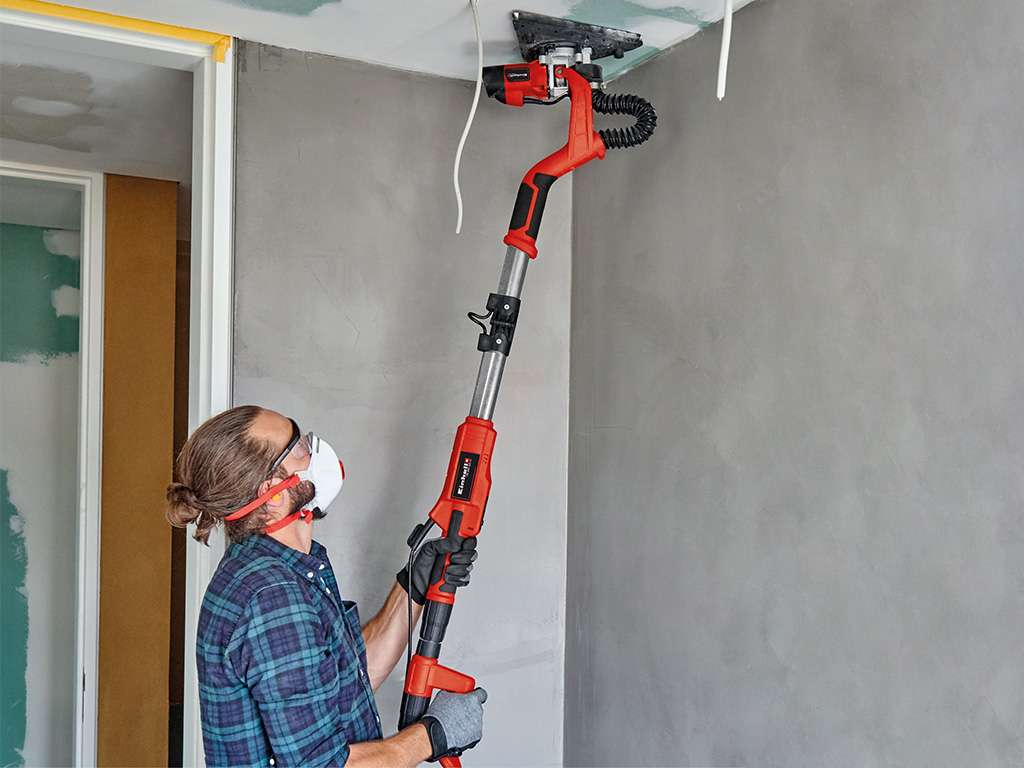
Other important devices for wall treatment
- Drywall screwdrivers: The drywall components for your interior fittings can be easily connected to the Einhell cordless drywall screwdriver TE-DY 18 Li. As it specialises in drywall construction, the drill chuck is omitted here. You simply need to attach the bits and not a drill.
- Wall groove cutters: Still need more space in your brick wall for cables or pipes? Then the Einhell wall groove cutter TE-MA 1700 is just what you need. It mills into any masonry with a groove width that can be adjusted up to 38 mm.
- Wet/dry vacuum cleaners: The Einhell wet/dry vacuum cleaners are ideally suited as suction devices for the drywall sander. With their high suction power, fine dust won't stand a chance. If you choose a vacuum cleaner model with an automatic power socket, you can connect the wired sander directly to it. Then the vacuum cleaner will switch on and off automatically with the grinder. For the cordless drywall sander, the cordless wet/dry vacuum cleaner TP-VC 36/30 S Auto is recommended. For automatic dust extraction, a special transmitter establishes a wireless connection to the drywall sander.





